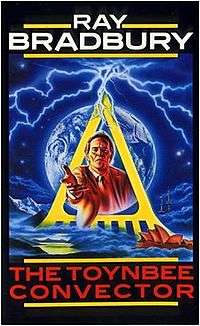The Toynbee Convector
| "The Toynbee Convector" | |
|---|---|
|
Cover of a reprint of The Toynbee Convector, which collects the story | |
| Author | Ray Bradbury |
| Country | United States |
| Language | English |
| Genre(s) | science fiction Short story |
| Published in | Playboy |
| Publication type | Periodical |
| Media type | Print (Magazine) |
| Publication date | January 1984 |
"The Toynbee Convector" is a science fiction short story by Ray Bradbury. First published in Playboy magazine in 1984,[1] the story was subsequently featured in a 1988 short story collection also titled The Toynbee Convector.
Plot summary
Roger Shumway, a reporter, is invited to visit Craig Bennett Stiles, a 130-year-old man also known as the Time Traveler. This is the first interview Stiles has granted since shortly after his return from the future, 100 years previously. Stiles had claimed then that he invented a time machine (which he privately refers to as his Toynbee Convector, although he does not reveal the name of the device to anyone until much later). Stiles used the machine to travel forward in time about a hundred years from what was an economically and creatively stagnant society (about 1984). On returning to that present, he showed evidence — films and other records collected on his journey — showing that humanity developed an advanced civilization with many marvelous and helpful inventions, and a restored natural environment. He also claimed to have then destroyed the machine deliberately to prevent anyone else doing the same.
Initially, people were skeptical of the Traveler's claims, but they are unable to explain or disprove the authenticity of the records brought from the future. Inspired by the prospect of a utopian future, many people began projects to fulfill the vision and create the world the Traveler claims to have seen.
A hundred years later, the perfect world of Stiles' visions has come to pass, just as he saw in his time travel. Now 130 years old, Stiles recounts the story to Shumway. Stiles calmly reveals what really happened, simply stating, "I lied." Since he knew the people of the world had it in them to create a utopia, he created the illusion of one, to give humanity a goal, and hope. Because of people's belief in the illusion, the imagined utopian future became reality. After explaining his actions, Stiles dies. As a pyrotechnic display appears overhead — the supposed past version of Stiles arriving via his time machine — Shumway resolves to travel to the future, too, and carry on Stiles' legacy. Although Stiles wanted Shumway to tell people the truth so that they would know they had saved themselves, the reporter decides to maintain the illusion and not expose the secret, and destroys the evidence that Stiles had left for him to reveal.
Origin of title
Within the story, Stiles says that he chose the name "Toynbee Convector" for his machine, being inspired by "a historian named Toynbee":
... that fine historian who said any group, any race, any world that did not run to seize the future and shape it was doomed to dust away to the grave, in the past.[2]
Bradbury almost certainly refers to Arnold J. Toynbee,[1] who proposed that civilisation must respond to a challenge in order to flourish.
Adaptations
The story was made into an episode of The Ray Bradbury Theater starring James Whitmore (as Stiles) and Michael Hurst (as Roger Shumway). It was first broadcast in 1990.[3]
See also
References
- 1 2 Hall, I. ‘The Toynbee Convector’: The Rise and Fall of Arnold J. Toynbee's Anti-Imperial Mission to the West. 2012. The European Legacy: Toward New Paradigms. 2012;17:4; 455-469.
- ↑ Dreher, R. Truth, history and the Toynbee Convector. 2010.
- ↑ "The Toynbee Convector". The Ray Bradbury Theater. Season 4. Episode 8. Internet Movie Database. October 26, 1990.
External links
- The Toynbee Convector title listing at the Internet Speculative Fiction Database
